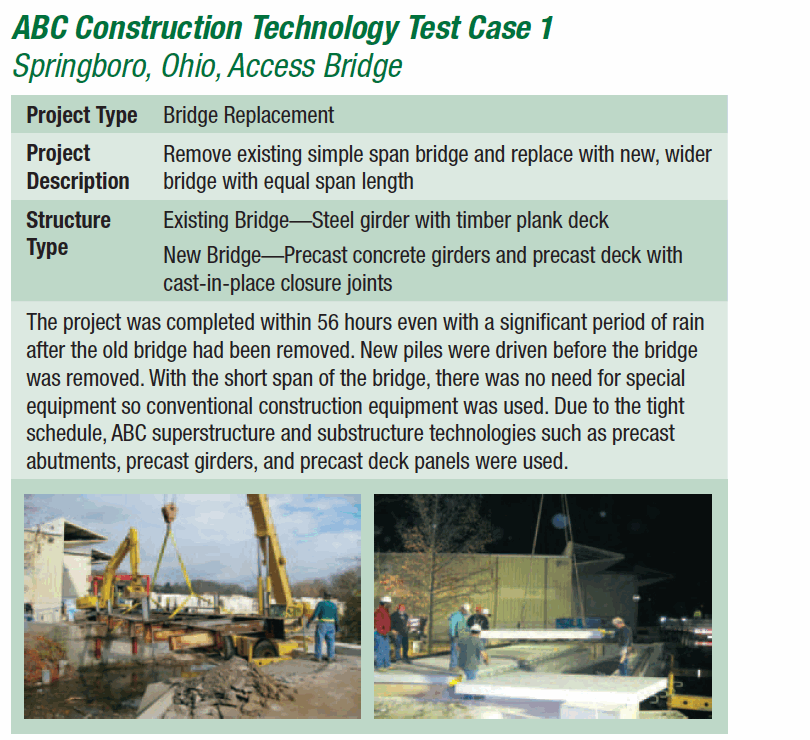TRANSPORTATION RESEARCH BOARD
Durability is a problem for today’s bridges. Bridge components break down. Soils become unstable. Bridge decks deteriorate, often unnoticed. Replacing bridges can be costly, time-consuming, and disruptive to traffic. And the cycle repeats as bridges age. Innovative methods have been developed for designing and constructing new bridges, repairing existing bridges, stabilizing bridge foundations, and nondestructively testing bridges; but they are not routinely used. Today’s innovations, however, can become tomorrow’s standards.
The second Strategic Highway Research Program (SHRP 2) is working closely with the Federal Highway Administration (FHWA) and the American Association of State Highway and Transportation Officials (AASHTO) to make today’s innovations more commonplace. Resolving obstacles to implementing innovation will mean that bridges can be created and replaced faster and be much more durable. Tomorrow, it will be standard for a bridge to have a service life of more than 100 years.
Bridge Construction
Traditional construction practices—such as erecting beams and framework, tying deck reinforcing steel, placing deck concrete, and allowing concrete to cure—are time-consuming and disruptive to traffic. Innovative design and construction solutions already exist to create new bridges and rapidly replace old bridges. These techniques make it possible to move large, prefabricated bridge elements or even major bridge systems. While total design and construction timeframes that do not affect traffic may remain significant, road closures may be limited to days or even hours using accelerated bridge construction (ABC) techniques.
Tomorrow, design concepts—such as precast abutments and piers, hybrid drilled shafts, segmental piers, complete composite steel superstructure systems, complete precast concrete superstructure systems, and space frame superstructures— will be standard. Ultra high-performance concrete (UHPC) will be used in joints. Using modern construction equipment—such as above-deck driven carrier systems, launched temporary truss bridges, wheel carriers, and self-propelled modular transporters (SPMTs)—to rapidly install bridges and bridge segments will also be standard. Standardizing these approaches will streamline the planning process. ABC Technology Test Cases 1 and 2 provide examples of how tomorrow’s standards are used today.
To help turn today’s innovations into tomorrow’s standards, SHRP 2 is developing standardized approaches for designing, constructing, and reusing complete bridge systems that address rapid renewal needs and efficiently integrate modern construction equipment.
To showcase tomorrow’s standards, SHRP 2 will conduct a field demonstration of ABC techniques in spring 2011. SHRP 2 is working in conjunction with the Iowa Department of Transportation to incorporate innovative bridge elements into a bridge located at US 6 over Keg Creek in Pottawattamie County, Iowa. While the original design for the bridge replacement would have required an estimated six-month road closure, the bridge replacement using ABC will limit road closures to two weeks. The demonstration, known as the Keg Creek Bridge Project, will showcase a prefabricated superstructure module (precast concrete deck on steel stringers), prefabricated substructure components (precast pier columns and caps and abutment stem and wing walls), and a prefabricated bridge approach (precast concrete panels and sleeper slab). This project will be the first in the United States to use UHPC to provide a full, moment-resisting transverse joint at the piers. A video of this demonstration will be posted on the SHRP 2 website.
Download full version (PDF): Tomorrow’s Bridges
About Transportation Research Board
www.trb.org
“The mission of the Transportation Research Board is to provide leadership in transportation innovation and progress through research and information exchange, conducted within a setting that is objective, interdisciplinary, and multimodal.”
Tags: OH, Ohio, Transportation Research Board, TRB















 RSS Feed
RSS Feed